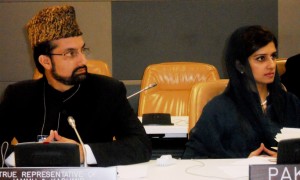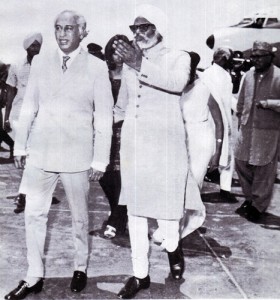Peace Watch » Editor's Take » Hurriyat (M) Going Pakistan What For Is The Question.
Hurriyat (M) Going Pakistan What For Is The Question.
Story of Paradigm Shift
Z.G. MuhammadAre we a paranoid people- you and me included? Is it, fear rooted in my mind that makes me ponder over something, I would in normal course dismiss as nonevent and of consequences.
Chairman APHC (M) and four other members of his executives’ council are visiting Pakistan in November. What is ‘big deal’ about it? For past many years, these leaders have been visiting Islamabad and meeting men in power. Now their visits to the country and meeting leaders’ is no news. Why should it engage my attention, is the question.
There were times when Kashmir leader visiting Islamabad made big news. In 1964, when Sheikh Abdullah at the behest of Indian Prime Minister, Jawaharlal Nehru visited Islam it made big news on two counts: one, Sheikh was visiting the country he abhorred and opposed from 1947- 1953 for the first time and second he was travelling with a brief or formula from Prime Minister of India for President Ayub Khan. Nehru’s formula continues to remain classified document to date. And if Stanley Wolpert in “Zulfi of Pakistan” is to be believed it revolved around division of the state along the Chenab, a step further to the discussions between Swaran Singh and Zulfikar Ali Bhutto from December 1962 to May 1963. This visit of Abdullah being first such visit after the birth of problem finds a mention in footnotes of Kashmir history.
In 2005, when leaders of this umbrella organization travelled through the Jhelum Valley Road to Islamabad for meeting then President General Musharraf, there was no element of surprise in it. The purpose of the visit was more than obvious. The President wanted their nod for his half-baked 4pt formula. He also wanted to take on board Kashmir leaders and parties believing in finality of accession of state with India.
I have earlier also written that General Musharraf had not authored the document but it was broadly discussed in a 60 page booklet, “India Pakistan and The Kashmir Tangle- What Next” by Pran Chopra in 1994. And further amplified by Eqbal Ahmed in a couple of articles published in the Dawn Pakistan in nineties. Chopra had written about making LOC porous, allowing people to travel and trade across it with ease. He had also talked about joint management. He however had doubted if Pakistan would “agree” as it would be a major shift in its Kashmir policy but he was certain “India would.” agree.
Talking about Sino-Indian and Indo-American relations he had further said, “India and Pakistan relations should also cease to be hostage to the disputes between the two countries, and while both the countries should certainly chisel away at disputes, the scope of agreements in uncontroverted areas should be allowed to rise to its full potential.” Doubting Pakistan agreeing to this proposition as it would go against its “stated position” , at that juncture Pakistan saw the ‘resolution of core issue- Kashmir’ as gateway to the resolution of all other disputes. On reading, the 1994 essay of Chopra it can be construed that 4pt formula originated from New Delhi and not Islamabad.
The apprehension expressed in essay written under the aegis of India’s Centre For Policy Research have now been set at rest as ‘not making India-Pakistan relations’ hostage to Kashmir’ is now the policy plank of the government in Islamabad. Some Pakistan commentators see it as, “countries diplomatic retreat”.
On a number of counts, the proposed visit of a faction of APHC (M) looks different from that in 2005: one, the timing. Two, it making a departure by talking about the visit to people outside the caucus and inviting LOC traders, some professionals and activists for drafting a “blue Print” for talks, third suggesting that it has no set agenda for the talks and fourth the phraseology used with regard to resolution of the Kashmir dispute in the party press notes.
Of all these, it is the phraseology used in the party press notes that caught my imagination. It reminded me how phraseology has been a determinant in changing the contours and contents of the major Kashmir narrative and how it has delayed the resolution of the problem. In fact, change in phraseology has been a presage of change in the narratives of political organizations in the state. History of phraseology changing the content and contours of political struggle can be traced to mid thirties. It is beyond the scope of this column to dwell upon how the Congress leadership more particularly Jawaharlal pushed in the communist ideologues into Kashmir to added a new phraseology to the struggle in forties and steer it in a desired direction.
Let me start with the most recent period, from 1955 to 1968, the main narrative of the Plebiscite Front was ‘right to self-determination for people of the state as enshrined in the UN resolutions and the catch phrase was “ plebiscite.” In 1968, by calling the State Peoples Convention for exploring ‘alternative solution’, it in fact questioned the very constitution of the organization. After 1972, it dropped phrases like right to self-determination and plebiscite and invented new phraseology, “our battle with New Delhi is not over quality of accession but quantum of accession”. This paradigm shift in phraseology led to the dissolution of the Plebicite Front and burial of old phraseology- like “right to self-determination” and “Plebiscite” and gave birth to many new phrases like ‘Azat-Abaroo Kay Muqam”etc- which with all its vagueness died its natural death.
In 1990, when a phrase Azadi- which was one word substitution for right to self-determination resonated allover the state and it became the only political phrase which caught international attention. The political leadership felt the urge of articulating the new phrase in an organized way . The Hurriyat Conference, a conglomerate of diverse political belief was born. In its constitution, it incorporated word “negotiated settlement”, I saw this incorporation as a paradigm shift for creating scope of flexibility in the main narrative and coining of new phrases.
The APHC(M) in place of ‘right to self-determination has now coined a new phrase, “K-resolution according to emotions and aspiration”. T his conjuration is not a part of any international lexicon about resolution of the disputes but a very vague term that could be stretched in any direction. Is this changed phraseology indicative of any mindset with which the group is going to Islamabad? If it is an indicator, the scope of discussions is restricted to the strengthening of some Kashmir related CBM, like trade and travel across. If the travel is regarding CBM’s, even then it raises some questions. Why discussion first with Islamabad and not New Delhi. Is New Delhi privy to the agenda the five are carrying to Islamabad- in other words is it in the ‘loop’- or do they at all have an agenda or they are going there to get some moot points- what could be those moot points. The visit cannot be without New Delhi’s nod as a top leader of the group says, “I do not know if New Delhi is informed about agenda but it is a long pending visit and it cannot happen without New Delhi’s approving our travel documents.”
his conjuration is not a part of any international lexicon about resolution of the disputes but a very vague term that could be stretched in any direction. Is this changed phraseology indicative of any mindset with which the group is going to Islamabad? If it is an indicator, the scope of discussions is restricted to the strengthening of some Kashmir related CBM, like trade and travel across. If the travel is regarding CBM’s, even then it raises some questions. Why discussion first with Islamabad and not New Delhi. Is New Delhi privy to the agenda the five are carrying to Islamabad- in other words is it in the ‘loop’- or do they at all have an agenda or they are going there to get some moot points- what could be those moot points. The visit cannot be without New Delhi’s nod as a top leader of the group says, “I do not know if New Delhi is informed about agenda but it is a long pending visit and it cannot happen without New Delhi’s approving our travel documents.”
On the face of this visit of APHC(M) to Islamabad has all vagueness in it but still it needs to be watched if it does not mean presage a changing main discourse…”
Article was published in Greater Kashmir on 19-11-12, unfortunately some typos had remained in the print edition which have been corrected,
Filed under: Editor's Take · Tags: Book Srinagar Review, Hurriyat Conference, Kashmir, Mirwaiz Farooq








